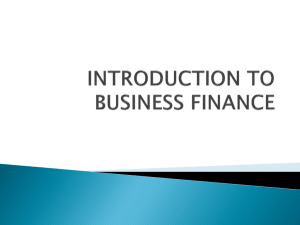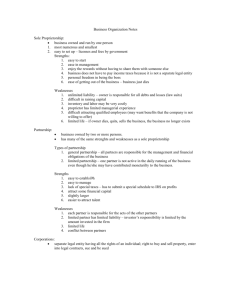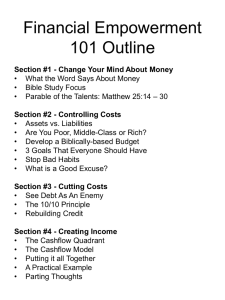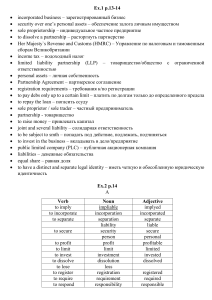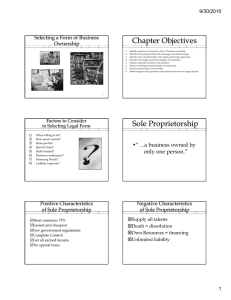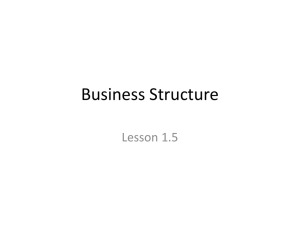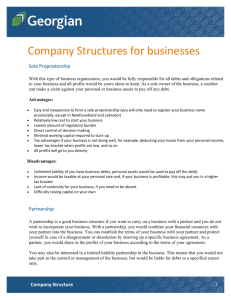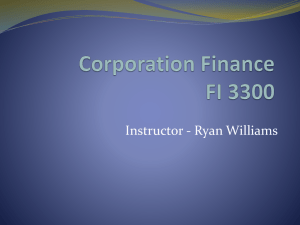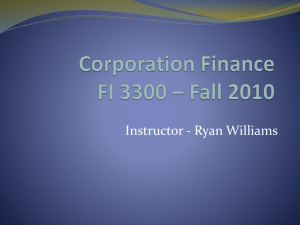lecture 1 jdps
advertisement
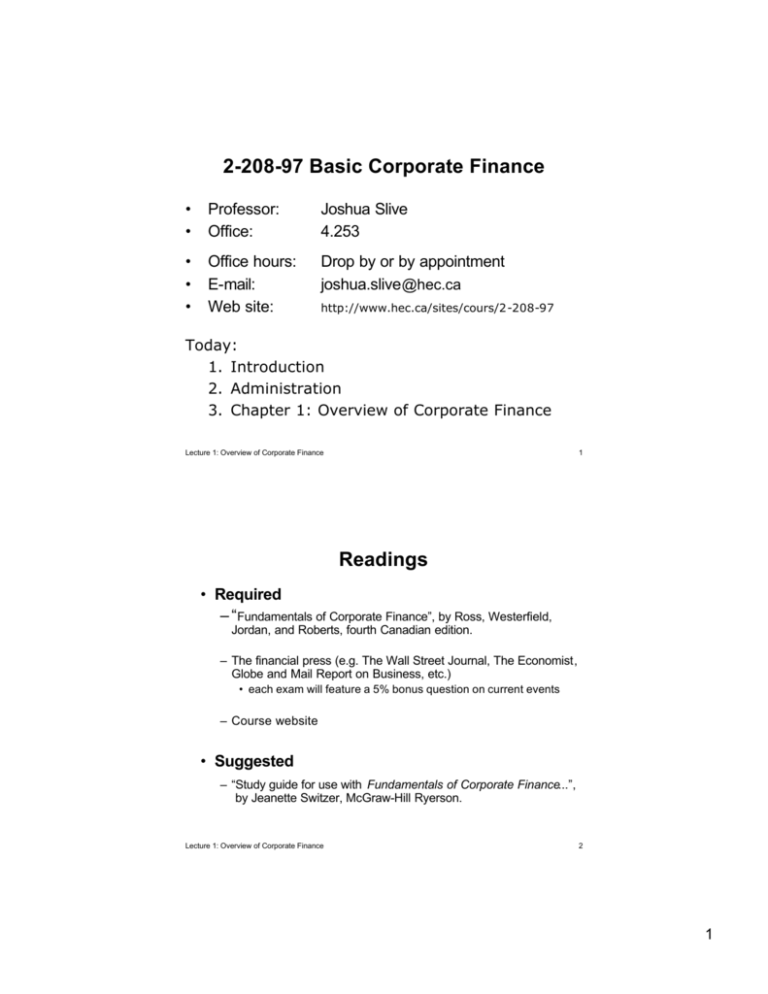
2-208-97 Basic Corporate Finance • • Professor: Office: Joshua Slive 4.253 • • • Office hours: E-mail: Web site: Drop by or by appointment joshua.slive @hec.ca http://www.hec.ca/sites/cours/2-208-97 Today: 1. Introduction 2. Administration 3. Chapter 1: Overview of Corporate Finance Lecture 1: Overview of Corporate Finance 1 Readings • Required – “Fundamentals of Corporate Finance”, by Ross, Westerfield, Jordan, and Roberts, fourth Canadian edition. – The financial press (e.g. The Wall Street Journal, The Economist, Globe and Mail Report on Business, etc.) • each exam will feature a 5% bonus question on current events – Course website • Suggested – “Study guide for use with Fundamentals of Corporate Finance...”, by Jeanette Switzer, McGraw-Hill Ryerson. Lecture 1: Overview of Corporate Finance 2 1 How the Course Works • This course is designed to provide – knowledge of the basic concepts that are specific to the finance field; – foundations that will be used in later finance courses. • To get the most out of this course, understand the parts and their purpose: – Lectures – Books (text & study guide) – Exercises (in the text and study guide) – CD-ROM – Other stuff (internet sites, market simulations, financial press...) Lecture 1: Overview of Corporate Finance 3 Evaluation • You are responsible for everything in the required readings and everything in the lectures • Mark distribution: – Quiz (fifth class): 10% – Mid term exam: 30% – Assignment (due last class): 20% – Final exam: 40% • All questions will be in English, but you may answer in English or French. • A laptop or financial calculator will be required for the exams. Lecture 1: Overview of Corporate Finance 4 2 Chapter 1 - Introduction to Corporate Finance • What is Corporate Finance? • Role of the financial manager • Financial Management Decisions – Capital budgeting – Capital structure – Working capital management Lecture 1: Overview of Corporate Finance 5 Course in a Nutshell The Market The Firm Capital Structure Capital Budgeting Stockholders Dividends Equity Debt Bondholders Cash flow Financial Manager Investments Interest Personal Taxes Projects Corporate Taxes Government Lecture 1: Overview of Corporate Finance 6 3 A Simplified Organizational Chart (Figure 1.1) Board of Directors Chairman of the Board and Chief Executive Officer (CEO) President and Chief Operations Officer (COO) Vice President Marketing Vice President Finance (CFO) Treasurer Vice President Production Controller Cash Manager Credit Manager Tax Manager Cost Accounting Manager Capital Expenditures Financial Planning Financial Accounting Manager Data Processing Manager Lecture 1: Overview of Corporate Finance 7 Forms of Business Organization Sole proprietorship – Examples: Your own lemonade stand; A professional in private practice – Easy to setup – No distinction between owner and business: • Unlimited liability • Profits are personal income • Difficult to transfer Partnership – Example: Law firm – Similar to a sole proprietorship, but: • Shared resources, revenues and responsibilities • One partner can act on behalf of others – Types of partnership agreements: • General: everything shared • Limited: some partners have limited liability Lecture 1: Overview of Corporate Finance 8 4 Forms of Business Organization Corporation – Example: most businesses, ranging from an individual plumber to a multi-national – Separate legal entity: • • • • Taxed separately from the individual ? double taxation Limited liability ? owner only liable for investment Unlimited lifespan, transferable ownership Ownership can be separated from management – Slightly complicated to setup • Articles of incorporation • Bylaws Lecture 1: Overview of Corporate Finance 9 Forms of Business Organization Which is better for: – Getting a small business started quickly without much hassle (eg. lemonade stand)? – Obtaining a bank loan to finance a startup business? – Protecting the owner of a risky business? – Attracting outside investors? – Selling a business? – Minimizing taxes? (How are dividends taxed?) • Businesses require both skill and capital, but they need not come from the same person. Lecture 1: Overview of Corporate Finance 10 5 The Goal of Financial Management When making financial decisions, what should be the enterprise’s goal? Lecture 1: Overview of Corporate Finance 11 Agency Problems • Knowing what is the goal of the shareholders, how do we get the managers to work towards that goal? • Definition of agency problem – Conflicts of interest between the shareholders and management of a firm • Agency costs – direct: shirking, monitoring costs – indirect: foregone investment opportunities or excessive investment • Solutions to agency problems – compensation plans tied to increases in firm value – control (monitoring and corporate takeovers) – long-term relationships Lecture 1: Overview of Corporate Finance 12 6 Financial Institutions, Financial Markets and the Corporation • What types of financial institutions are there and what do they do? • Financial markets – Money markets versus capital markets – Primary markets versus secondary markets Lecture 1: Overview of Corporate Finance 13 Comparison Between Accounting and Finance • Accounting and finance worry about different goals • accounting worries about control of funds and accountability • finance worries about decision making and creating value • This means that accountants and financial managers might want to record and report the firm’s performance differently. • Two recurring differences • book value versus market value • cashflow versus income Lecture 1: Overview of Corporate Finance 14 7 Book Value versus Market Value • Market Value: – In finance, something is valuable only to the degree that someone is willing to pay for it. – Market value is defined as the most that someone is willing to pay – We use market value for financial decisions • Book Value: – Based on historic value (purchase price) and depreciation – Much less subjective than market value – Changes less frequently than market value – Therefore easier to track and better for accounting • Book value is close to market value when the asset is more – Liquid – Short-term – Example: cash • Which is higher, book value or market value? Lecture 1: Overview of Corporate Finance 15 Income versus Cashflow • How do we measure if a firm is profitable? • Examples: – We make a big sale today but allow the customer to pay in 24 months. When should we record the revenue? – We buy a delivery truck that will last us ten years. When should we record the expense? • Cashflow – simple to measure – highly variable and hence not a good measure of profitability • Income – income & expense accrual and matching principles – non-cash items (ex.:depreciation expense) Lecture 1: Overview of Corporate Finance 16 8 What we know now • What is corporate finance • Basic forms of business organization: – Differences between a sole proprietorship and a corporation – Advantages and disadvantages of each • Goals of financial management and agency problems in achieving those goals • Financial markets and institutions • Accounting versus Finance – Book value versus market value – Income versus cash flow Lecture 1: Overview of Corporate Finance 17 9
